Reading a fantasy book, envisaging yourself living in an imaginary world, and identifying yourself with your favourite character - such is the feeling of reading a book full of imaginations which stays with you for a long long time. We all try to visualize something far from the reality and technological advancement has made it possible to not only imagine things but to actually see them right in front of our eyes. Augmented reality is the futuristic tech marvel that can be integrated with Drupal to build a tech genius.
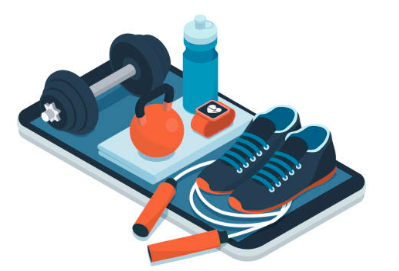
So, what is Augmented Reality (AR)? Gartner defines AR as the real-time use of information in the form of text, graphics, audio and other virtual enhancements integrated with real-world objects. It is this “real world” element that differentiates AR from virtual reality. AR integrates and adds value to the user’s interaction with the real world, versus a simulation.
The evolution of AR is staggering and interesting at the same time.
How did Augmented Reality come into being?
The user of one of today’s visual displays can easily make solid objects transparent - he can “see through matter!”
- Ivan Sutherland
Today informational overlays layered on top of the physical world is the talk of the town. Back in the 1960s, 1965 to be precise, Ivan Sutherland talked about immersive displays in an essay and created the first-ever head mounted display in 1968.
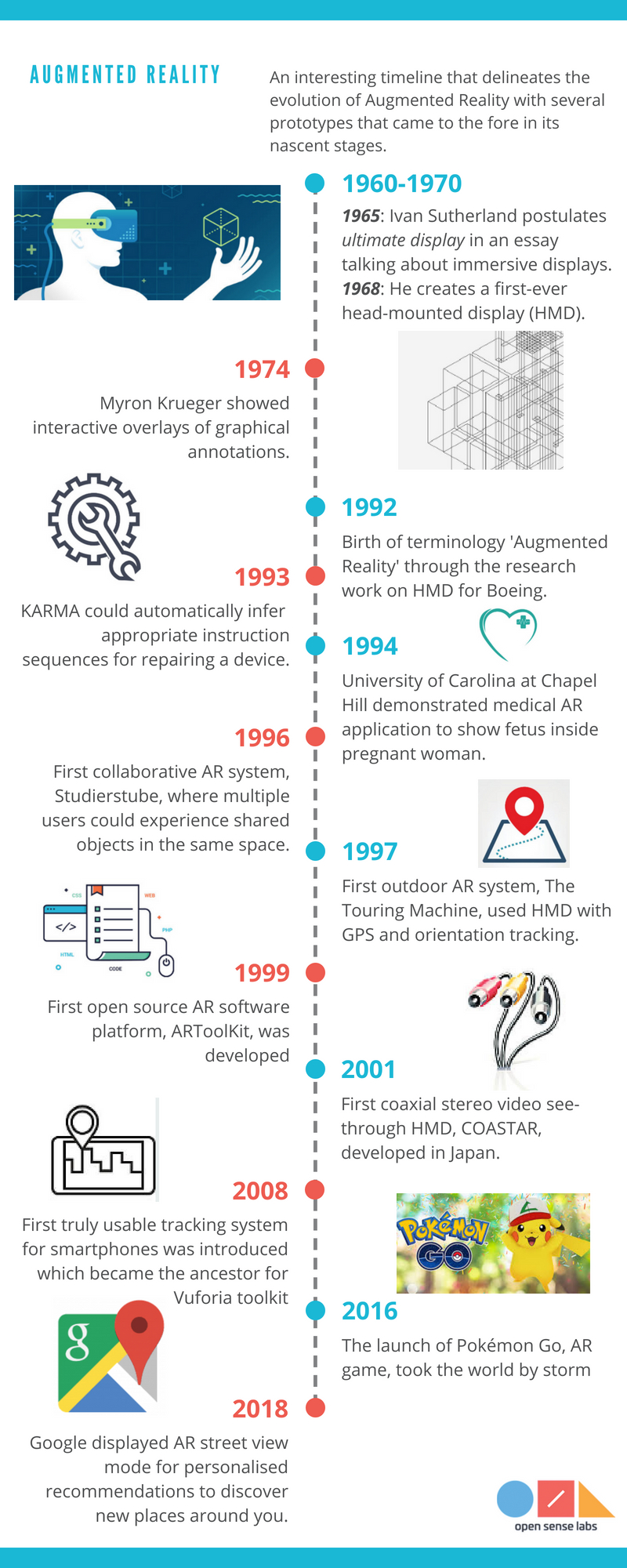
Krueger demonstrated collaborative interactive overlays of graphical annotations in 1978. Fast forward to 1990s, we would witness plenty of research works and prototypes. In 1992, terminology called Augmented Reality was for the first time seen in a research at Boeing. Subsequent discoveries like KARMA in ‘93, first medical AR application in ‘94, Studierstube in ‘96, The Touring Machine in ‘97, and ARToolKit in ‘99 paved the way for many complex innovations post the millennium.
The launch of Pokémon Go had almost 45 million users at its peak in 2016. More recently, in 2018, Google displayed AR street view mode to help you in the real time in addition to personalized recommendations to discover new places around you.
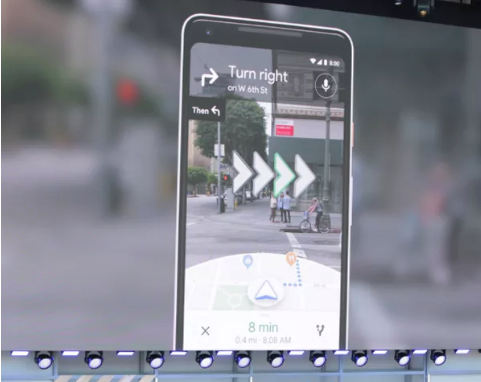
Today, AR developers have a lot of options to choose from when it comes to software platforms dedicated to AR. But these inventions had a lot to offer in terms of guidance and model.
Types of Augmented Reality
AR did come a long way to go for commercial use. There are different classifications within AR.
- Marker-based AR: It is also known as image recognition AR is the easiest to implement. It used a trigger object to display content. Google Goggles, Popcode, and ScanLife are some of the examples.
- Markerless AR: It is more versatile than the market-based AR. In place of trigger object, it uses cameras, GPS and accelerometer information to track the user location and offer them relevant content. Examples of markerless AR include ARIS and Layar.
- Projection-based AR: It projects digital images directly onto a surface within the user’s surrounding. Disney theme park has employed projector camera toolbox that builds 3D objects to enhance theme park experience.
- Outlining AR: It uses image recognition to outline shapes and boundaries. It can be used to help drivers see the edges of the highway in dim light for safe driving.
- Superimposition-based AR: It uses object recognition to replace an object within the user’s surrounding either partially or fully with a digital image. For instance, a surgeon can use such technology for adding digital x-rays over a part of a patient’s body during a surgery.
Applications of Augmented Reality
Whether it’s transportation or sports, AR has a lot to offer for different industries. Let’s see all of them.
Retail industry can reap the benefits of AR to a great effect. IKEA has an AR application called IKEA Place which allows customers to preview thousands of virtual furniture in the actual room within their home.
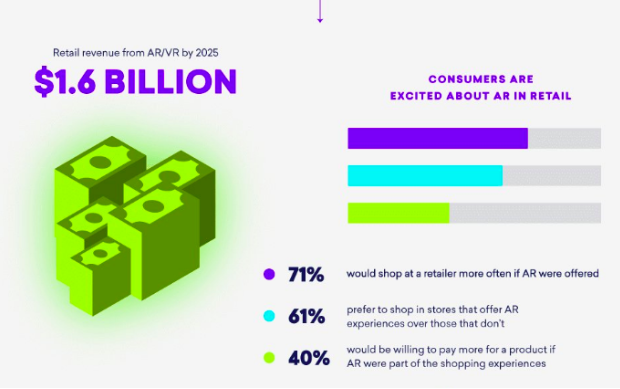
Transportation sector can also explore AR to simplify their work. Aero Glass have created AR headsets that can display airports, navigation points, terrain features etc. for the pilots.
AR can be a big boon for the sports industry. Stubhub developed a feature on their mobile application that would allow ticket buyers of the Super Bowl to see a virtual 3D model of the stadium and the surrounding area.
It has immense potential in the education sector as well. An application like AR Flashcards Animal Alphabet can help children in learning alphabets easily by bringing flashcards to life.
Healthcare industry promises to be one of the most important areas for AR to be explored with a vast potential. AccuVein uses AR technology to help nurses find veins more easily while inserting IVs.

Marketing sector can’t be far behind. In 2014, by installing outward facing cameras in a London bus shelter and projected UFOs, robots, balloons, and tigers, Pepsi took the promotional campaign to a whole new level.
Working Principle of Augmented Reality
AR is great on so many levels for a multitude of industries. How does augmented reality work?
Sensors can be found on the outside of the AR devices that gather data regarding user’s real-world interactions and process them.
Cameras, also located on the outside of the AR device, scan the surrounding area and uses this information to determine the appropriate output.
Projection based AR works through miniature projector which is found in an outward-facing AR device. They can turn any surface or object into an immersive environment. The data collected by the cameras is projected onto the surface through projection-based AR devices.
AR devices are like mini-supercomputers that require a great deal of computer processing power. They use many of the same components that the smartphones do which includes CPU, GPU, flash memory, RAM, Bluetooth/Wifi microchip, GPS microchip, etc.
AR devices can also use mirrors for reflection to help in viewing the way our eyes view the virtual image. While some AR devices may use an array of small curved mirrors, other AR devices can use a double-sided mirror with one surface that reflects incoming light to the camera which is side-mounted and the other surface would reflect this light to the user’s eye.
Drupal and Augmented Reality Use Cases
A Drupal agency built a chatbot prototype which assisted customers to select recipes based on the health constraints and their preferences. Interactive experience with the chatbot could make their life easier and forbade them from intensively researching for their grocery shopping. To improve it further, they tried to integrate AR in Drupal.
The demonstration shown in this video displayed a shopper interacting with the AR application. The mobile application of Freshland Market (a fictional grocery store), built on Drupal 8, guided the shopper through her shopping list.
It also assisted her to make better decisions while shopping through AR overlays. It superimposes relevant details like price, product ratings, and recommendations over the shopping items detected by the smartphone camera. The mobile application personalised the shopper’s experience by displaying the products that were best for her dietary restrictions and her preferences.
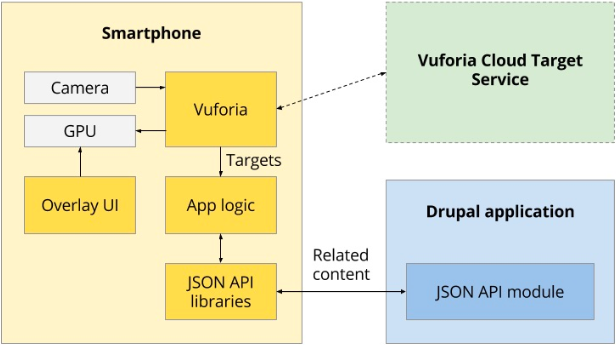
Drupal’s web services support and JSON API module helped in serving content to the mobile application. The Drupal 8 site of Freshland Market stored all the product related information including price, dietary constraints, and reviews and ratings. If Drupal content for one of the products is edited to show the item as being on sale, it automatically reflected in the content superimposed through the mobile application. In addition to this, the location of the product was also stored on the site to guide the shopper to the product’s location in the store.
The application was developed using AR library, Vuforia, which identifies pre-configured targets like images of product labels. For instance, in the demonstration, it identifies tomato sauce and cereal labels. Each of these targets was given a unique ID to query the Freshland Market’s Drupal 8 site thereby finding the content related to those targets.
Another use case is the Lift HoloDeck prototype which was built using commercially available technologies like Drupal(content store), Acquia Lift(a personalised engine), Vuforia(AR library) and Unity(3D game engine).
Lift HoloDeck team built a mobile application that superimposes product information and smart notifications over real-life objects that are detected on the smartphone’s screen. It could change the way customers interact with brands and improve the customer experience.
Let’s say a user informs about his purchases to a coffee shop through this mobile application. When he enters the shop, he would show his phone screen displaying “deal of the day”. The application superimposes dietary information, directions on how to order, and product information on top of the beverage. By going through the nutritional facts, he would order his preferred choice and would receive notification that his order was ready to be picked up.
Future of Augmented Reality
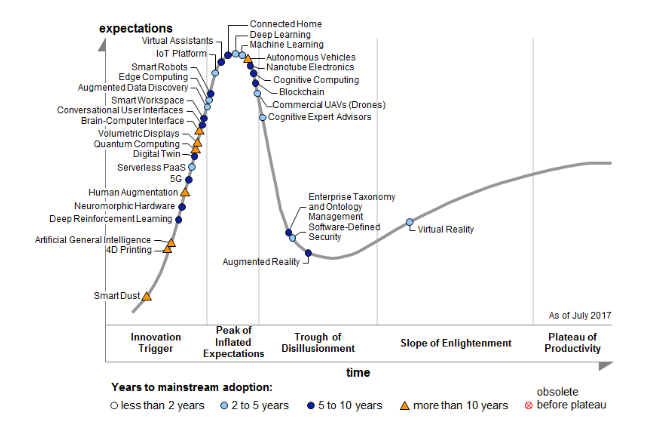
What is the future of augmented reality? Gartner Hype cycle discovery in 2017 suggests that it will take another 5 to 10 years for the mainstream adoption of AR.
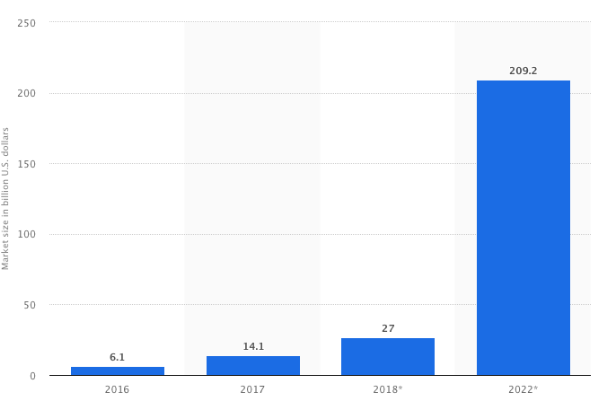
The graphical representation, mentioned above, clearly states that AR is going to be a force to reckon with in the coming years. The market share of AR is going to witness a dramatic transformation in the coming years.

By 2025, the biggest industries for AR, as shown in the graph above, will be the gaming and the healthcare industries followed by the engineering, real estate, and retail sectors.
Conclusion
The world is changing. And it is changing at an unimaginable pace. Technologies like augmented reality were once a part of our huge list of fantasies. Many of your fantasies can come true with this awesome piece of disrupting technology. With Drupal as a content store, designing an AR-driven web and mobile applications can be highly rewarding for your organization.
Talk to Drupal experts, ping us at [email protected] to get the best of Drupal and augmented reality for your future businesses.
Subscribe
Related Blogs
Back from DrupalCon Atlanta 2025: A Milestone Moment for OpenSense Labs

“Fit. Fast. Built to Last.” That wasn’t just a tagline, it was the mindset we brought to DrupalCon Atlanta 2025. And judging…
Explainable AI Tools: SHAP's power in AI

Do you know what are explainable AI tools? Explainable AI tools are programs that show how an AI makes its choices. They help…
AI Chatbot: Crafting with Precision & Personality

In the realm of artificial intelligence, developing an AI chatbot that not only delivers accurate information but also…




